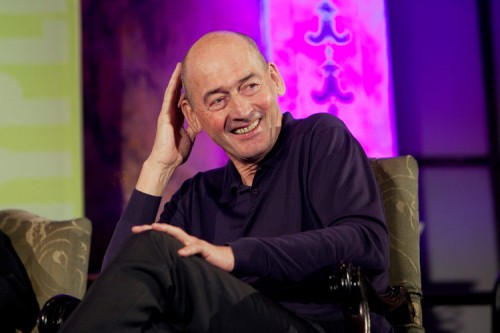
Rem Koolhaas cut the interviewer short when asked if he had any regrets: “That’s a private matter and therefore not one I will answer.” And yet the entire hour-long conversation provided what seemed to be almost shockingly intimate glimpses into the architect’s state of mind, where feelings of being lonely, isolated, ineffectual, nostalgic, and even old seemed simmering.
The event was LIVE, a series offering public interviews of topical characters, held in a sumptuous Victorian-age hall at the New York Public Library. And Rem Koolhaas with Hans Ulrich Obrist were there to talk with event curator Paul Holdengraber about their new book Project Japan: Metabolism Talks. The capacity audience numbered over 400, strong in architect professionals, including Marion Weiss, Michael Manfredi, SO-IL’s Jing Liu, Beatriz Colomina, Paul Goldberger, Suzanne Stephens, MoMA’s Pedro Gadhano, and Family’s Dong-Ping Wong among so many others.
And they were all ears when Holdengraber said he had asked Koolhaas and Obrist to define themselves in seven words: Koolhaas gave a clear-cut six: mystic, rational, sober, baroque, patient, immediate. Obrist, sort of eight: catalyst, conversation, curating curiosity, guidance-making, and protest against forgetting.
In a brief introduction, Koolhaas returned to a subject he’d addressed at the Japan Society a few nights before: How Kisho Kurokawa managed to be a magazine-posing celebrity architect in his day (1950s and 60s) who was still taken seriously enough to influence the direction of postwar Japan. “He was prominent enough to interview the prime minister,” Koolhaas noted, and you could almost feel the waves of longing and envy welling up. Today, he said, the effect is the opposite: the more media exposure, the less architects are taken seriously. Even more, the architect said, Kurokawa provided a postwar model for being male in Japan. (And that without wearing a black turtleneck.)
The Metabolists worked together, and with the country almost entirely in ruins, their thinking as a group became “an extension of the imagination of the state.” Perhaps. What the Metabolists actually recommended in terms of architecture—floating fortresses, sky villas, pod-dwellings—seemed less of interest than the camaraderie of ideas. In contrast, Koolhaas said, “We are all lonely operators with very little cooperation. They could stand together and work in a movement.” And though the work itself dealt with impossibilities of scale and entirely broken down systems in desperate need, the united effort was “a miracle to behold.”
Glossing over the homogeneity of postwar Japanese society with competitive zeal fueled by peer humiliations, Koolhaas apparently finds that zeitgeist preferable to today’s market economy where “architecture has been warped and separated from anything important and no longer serves the public good, but only the good of private interests.”
The sheer Japanoiserie of Japanese architecture impressed both Obrist and Koolhaas who attribute that quality to modern architects having never cut off tradition but allowing it to flow continuously from the past and into their work. The same, he said, could never be said of a French, Dutch, or Swiss architect (pace Zumthor).
It means something to be a Japanese architect, Koolhaas contended, while elsewhere, “architects have disintegrated to insignificance.” Such self-flagellating remarks have been voiced before by the profession’s most Sphinxian sage. And yet when he spoke of meeting with surviving Metabolists—some of them politically reactionary, to his surprise— it was how they coped with their advancing years that seems to have caught his attention most: “Perhaps old age requires strategy more than any other point in life. The conversations demonstrated touchingly that it is more crucial to exploit your limitations than to survive your gifts. As memory weakens, vision is your only option,” Koolhaas said at the end, paraphrasing his book and, still marveling, added “It was magnificent to see the tactical ticking in their brains on how to make a good impression.” And so it was.